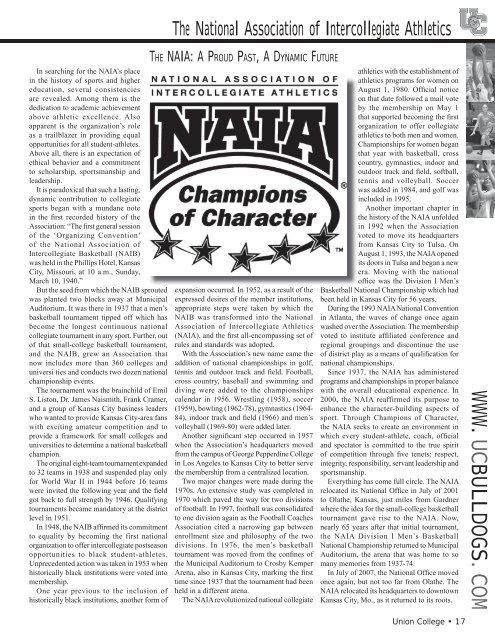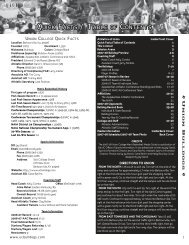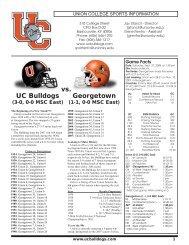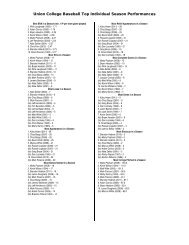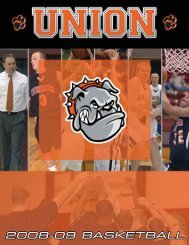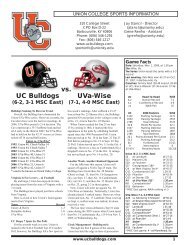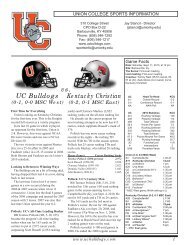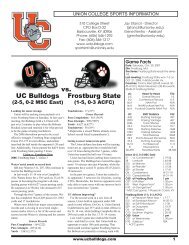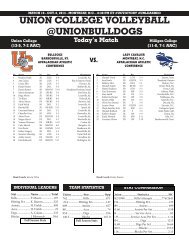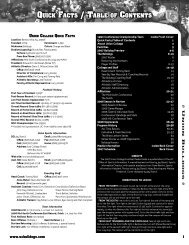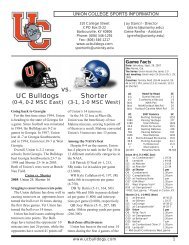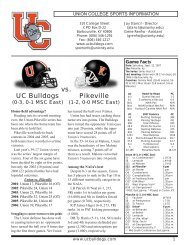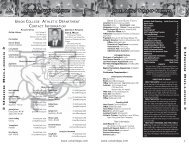WWW. UC BULLDOGS .COM
WWW. UC BULLDOGS .COM
WWW. UC BULLDOGS .COM
You also want an ePaper? Increase the reach of your titles
YUMPU automatically turns print PDFs into web optimized ePapers that Google loves.
The National Association of Intercollegiate Athletics<br />
In searching for the NAIA’s place<br />
in the history of sports and higher<br />
education, several consistencies<br />
are revealed. Among them is the<br />
dedication to academic achievement<br />
above athletic excellence. Also<br />
apparent is the organization’s role<br />
as a trailblazer in providing equal<br />
opportunities for all student-athletes.<br />
Above all, there is an expectation of<br />
ethical behavior and a commitment<br />
to scholarship, sportsmanship and<br />
leadership.<br />
It is paradoxical that such a lasting,<br />
dynamic contribution to collegiate<br />
sports began with a mundane note<br />
in the first recorded history of the<br />
Association: “The first general session<br />
of the ‘Organizing Convention’<br />
of the National Association of<br />
Intercollegiate Basketball (NAIB)<br />
was held in the Phillips Hotel, Kansas<br />
City, Missouri, at 10 a.m., Sunday,<br />
March 10, 1940.”<br />
But the seed from which the NAIB sprouted<br />
was planted two blocks away at Municipal<br />
Auditorium. It was there in 1937 that a men’s<br />
basketball tournament tipped off which has<br />
become the longest continuous national<br />
collegiate tournament in any sport. Further, out<br />
of that small-college basketball tournament,<br />
and the NAIB, grew an Association that<br />
now includes more than 360 colleges and<br />
universi ties and conducts two dozen national<br />
championship events.<br />
The tournament was the brainchild of Emil<br />
S. Liston, Dr. James Naismith, Frank Cramer,<br />
and a group of Kansas City business leaders<br />
who wanted to provide Kansas City-area fans<br />
with exciting amateur competition and to<br />
provide a framework for small colleges and<br />
universities to determine a national basketball<br />
champion.<br />
The original eight-team tournament expanded<br />
to 32 teams in 1938 and suspended play only<br />
for World War II in 1944 before 16 teams<br />
were invited the following year and the field<br />
got back to full strength by 1946. Qualifying<br />
tournaments became mandatory at the district<br />
level in 1951.<br />
In 1948, the NAIB affirmed its commitment<br />
to equality by becoming the first national<br />
organization to offer intercollegiate postseason<br />
opportunities to black student-athletes.<br />
Unprecedented action was taken in 1953 when<br />
historically black institutions were voted into<br />
membership.<br />
One year previous to the inclusion of<br />
historically black institutions, another form of<br />
THE NAIA: A PROUD PAST, A DYNAMIC FUTURE<br />
expansion occurred. In 1952, as a result of the<br />
expressed desires of the member institutions,<br />
appropriate steps were taken by which the<br />
NAIB was transformed into the National<br />
Association of Intercollegiate Athletics<br />
(NAIA), and the first all-encompassing set of<br />
rules and standards was adopted.<br />
With the Association’s new name came the<br />
addition of national championships in golf,<br />
tennis and outdoor track and field. Football,<br />
cross country, baseball and swimming and<br />
diving were added to the championships<br />
calendar in 1956. Wrestling (1958), soccer<br />
(1959), bowling (1962-78), gymnastics (1964-<br />
84), indoor track and field (1966) and men’s<br />
volleyball (1969-80) were added later.<br />
Another significant step occurred in 1957<br />
when the Association’s headquarters moved<br />
from the campus of George Pepperdine College<br />
in Los Angeles to Kansas City to better serve<br />
the membership from a centralized location.<br />
Two major changes were made during the<br />
1970s. An extensive study was completed in<br />
1970 which paved the way for two divisions<br />
of football. In 1997, football was consolidated<br />
to one division again as the Football Coaches<br />
Association cited a narrowing gap between<br />
enrollment size and philosophy of the two<br />
divisions. In 1976, the men’s basketball<br />
tournament was moved from the confines of<br />
the Municipal Auditorium to Crosby Kemper<br />
Arena, also in Kansas City, marking the first<br />
time since 1937 that the tournament had been<br />
held in a different arena.<br />
The NAIA revolutionized national collegiate<br />
athletics with the establishment of<br />
athletics programs for women on<br />
August 1, 1980. Official notice<br />
on that date followed a mail vote<br />
by the membership on May 1<br />
that supported becoming the first<br />
organization to offer collegiate<br />
athletics to both men and women.<br />
Championships for women began<br />
that year with basketball, cross<br />
country, gymnastics, indoor and<br />
outdoor track and field, softball,<br />
tennis and volleyball. Soccer<br />
was added in 1984, and golf was<br />
included in 1995.<br />
Another important chapter in<br />
the history of the NAIA unfolded<br />
in 1992 when the Association<br />
voted to move its headquarters<br />
from Kansas City to Tulsa. On<br />
August 1, 1993, the NAIA opened<br />
its doors in Tulsa and began a new<br />
era. Moving with the national<br />
office was the Division I Men’s<br />
Basketball National Championship which had<br />
been held in Kansas City for 56 years.<br />
During the 1993 NAIA National Convention<br />
in Atlanta, the waves of change once again<br />
washed over the Association. The membership<br />
voted to institute affiliated conference and<br />
regional groupings and discontinue the use<br />
of district play as a means of qualification for<br />
national championships.<br />
Since 1937, the NAIA has administered<br />
programs and championships in proper balance<br />
with the overall educational experience. In<br />
2000, the NAIA reaffirmed its purpose to<br />
enhance the character-building aspects of<br />
sport. Through Champions of Character,<br />
the NAIA seeks to create an environment in<br />
which every student-athlete, coach, official<br />
and spectator is committed to the true spirit<br />
of competition through five tenets: respect,<br />
integrity, responsibility, servant leadership and<br />
sportsmanship.<br />
Everything has come full circle. The NAIA<br />
relocated its National Office in July of 2001<br />
to Olathe, Kansas, just miles from Gardner<br />
where the idea for the small-college basketball<br />
tournament gave rise to the NAIA. Now,<br />
nearly 65 years after that initial tournament,<br />
the NAIA Division I Men’s Basketball<br />
National Championship returned to Municipal<br />
Auditorium, the arena that was home to so<br />
many memories from 1937-74.<br />
In July of 2007, the National Office moved<br />
once again, but not too far from Olathe. The<br />
NAIA relocated its headquarters to downtown<br />
Kansas City, Mo., as it returned to its roots.<br />
<strong>WWW</strong>.<strong>UC</strong><strong>BULLDOGS</strong>.<strong>COM</strong><br />
Union College • 17


